Nightguard vital bleaching has brightened the smiles of many happy patients since its introduction in 1989. However, it remains difficult to achieve good bleaching results in patients whose teeth have been stained by tetracycline ingestion. Tetracycline can stain teeth if ingested by the mother in the third trimester or by the child during the years of tooth formation. Tetracycline also has been shown to stain teeth in adults who take the drug (eg, minocycline for long-term skin conditions such as acne) both by external absorption into the tooth and by internal deposition into the secondary dentin formed during aging or following trauma.
Tetracycline has several different analogues (eg, doxycycline, oxytetracycline, minocycline, chlortetracycline, demeclocycline) and may cause various types of stains in terms of color (gray, blue, brown, and yellow) and intensity. Recent research has shown that tetracycline-stained teeth may respond to longer bleaching treatments; whereas the bleaching time for other stains is 2 to 6 weeks, some tetracycline stains may require from 1 to 12 months (average of 3 to 4 months) of nightly treatment to achieve a satisfactory result. Brown and yellow discolorations, especially those that are uniform across the surface of the tooth or located in the incisal area of the tooth, are the most responsive; gray and blue stains in the gingival region of the tooth are least responsive. Teeth with banded discolorations have mixed responses, and composite bonding may be required to cover particularly unresponsive mid-tooth gray bands. Some seemingly normal yellow stains that are not responsive to the conventional 2 weeks of treatment may in fact be tetracycline stains. Although bleaching treatment of tetracycline stains involves extended times, research has shown that 6 months of nightly 10% carbamide peroxide bleaching is not detrimental to the tooth or pulp at 7.5-year recalls, and will provide some color improvement in almost every patient.1–3 Some tetracycline-stained teeth do not become totally unstained, but the tooth color is often much improved. Tetracycline-stained teeth that were gray often retain slight gray overtones (ie, they get lighter rather than whiter).
There are several factors to be considered when using extended time periods for bleaching tetracycline-stained teeth. First of all, the location of the stained area has a great impact on the prognosis for success. A tooth gets progressively thicker from incisal to gingival, which means that with bleaching, teeth generally lighten from the incisal to the gingival area, and teeth that are heavily stained gingivally have the poorest prognosis for complete lightening. Generally speaking, the further away from the cementoenamel junction the stain resides, the better the prognosis. However, in any situation, there is no way to predict whether the outcome of bleaching treatment will be successful. The patient must be willing to undertake the extended treatment time, recognizing that investing a reasonable amount of time and money is the only way to see if bleaching works for them. Patients should understand that they may not see results in the first few months after an initial slight lightening, although each discoloration responds very differently.
Extended treatment time also offers more opportunity for sensitivity episodes. Patients may have to reduce their exposure time (from overnight to 1 to 2 hours daily) or frequency (from every night to every second or third night or skipping weekends). As with regular bleaching, the presence of sensitive teeth pretreatment or the frequency of application of solution are the only predictors for sensitivity. In the extended treatment situations, the sensitivity may be sporadic and subside with no treatment. Patients may choose to apply fluoride solutions in the custom tray alternately with treatment or prior to application. The most predictable method used to treat sensitivity is the use of desensitizing toothpastes containing potassium nitrate for 2 weeks prior to bleaching, then the use of potassium nitrate in the tray for 10 to 30 minutes as needed during treatment. A reduction in the concentration of carbamide peroxide can also be helpful.
Another practical consideration in extended bleaching situations is the appropriate fee for the service. Practitioners may choose to have an increased total fee or to use the initial fee for their normal bleaching treatment, supplemented with an additional fee for each month of extended treatment. Using the latter “pay-as-you-go” approach, the additional monthly fee will only be for the office visit and the material needed. The patient continues to bleach until their teeth cease to change color, they have reached the desired color, or they are no longer interested in pursuing treatment. This approach is both fair to the dentist and to the patient, since it is highly difficult to predict treatment times for tetracycline staining.
Teeth severely stained in the gingival area generally are better candidates for porcelain veneers than for nightguard vital bleaching. However, it is best to try bleaching first, since it may have a satisfactory effect and eliminate the need for veneers. Even if the lightening effect is only slight and veneers still must be placed, the need for masking will be reduced, allowing the placement of more translucent—and thus more natural-looking—veneers. In cases where bleaching has no effect, the patient is at least confident that the most conservative avenues have been attempted first and that porcelain veneers are now the best option they have for an esthetic smile.
Early research on the longevity of color change indicates that most patients will have some degree of lightening, and 8 out of 10 patients can expect to retain that lightening for at least 1 year and for as long as 7 to 9 years. Even those patients who experienced some regression indicated they were glad they had bleached their teeth and would do it again.4
Dentists and physicians are well aware of the detrimental effects of tetracycline ingestion, although the absorption of tetracycline in teenagers taking the drug for treatment of acne has only recently been reported. However, tetracycline-stained teeth may continue to be seen since tetracycline is still the drug of choice for out-patient treatment of Rocky Mountain spotted fever and is the most widely prescribed drug for acne. Bleaching is a conservative, cost-effective consideration for treating tetracycline-stained teeth and a good treatment option if the patient is willing to undergo extended treatment and has reasonable expectations regarding the results.
CASE 1 Efficacy of nightguard vital bleaching to treat tetracycline stains
One of the first studies on extended nightguard vital bleaching treatment of tetracycline-stained teeth enrolled patients for 6 months of nightly treatment using 10% carbamide peroxide. Their total hours of treatment varied, based on lifestyle, sensitivity, and color change, from 568 to 1213 hours, with an average of 952 hours of nightly wear. No long-term problems had occurred at the 7.5-year recall.5,6
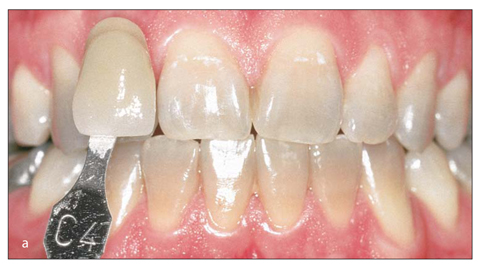
Moderate tetracycline stains before treatment in otherwise caries-free teeth.
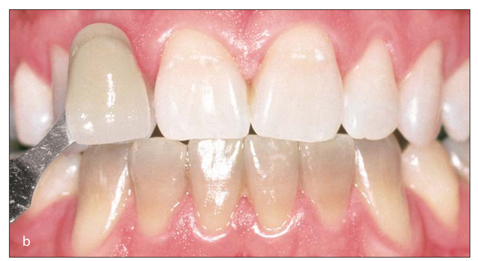
Results after 6 months of nightly bleaching in the maxillary arch with 10% carbamide peroxide for a total treatment time of 720 hours. The results are very good, and the patient reported no problems with sensitivity.
CASE 2 Single-arch bleaching
Single-arch treatment is the preferred approach to bleaching tetracycline-stained teeth. One reason is that in these cases the whitening process is often slow and difficult to notice; having the untreated arch for comparison allows the patient to see the progress that has been made, which encourages continued treatment. Also, some patients are unsure if they will be able to follow the treatment regimen due to either lifestyle issues or sensitivity. Starting with one arch allows the patient to attempt the procedure with the least possible cost and determine if they can continue with the full duration. Additionally, treatment of one arch reduces the potential number of sensitive teeth.
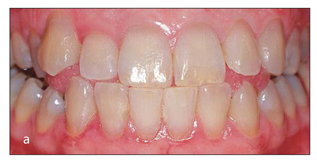
This patient presented with mild tetracycline staining and agreed to treat just the maxillary arch first. Generally, only the maxillary teeth show when the patient is smiling, although the mandibular teeth are often visible when the patient is talking.
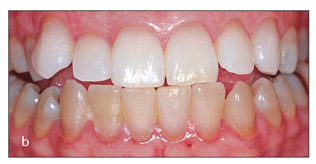
Nightly tray bleaching with 10% carbamide peroxide was performed on the maxillary arch for 9 months. The color change, which was very gradual and might otherwise be quite subtle, is easily visible in comparison with the mandibular arch.
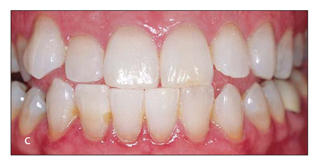
Following completion of bleaching of the maxillary arch, the mandibular arch was treated with nighttime bleaching for 6 months with good results.
CASE 3 Gradual color change in the treatment of tetracycline stains
Tetracycline causes stains that can be a number of different colors, depending on the analogue of the drug that was taken. These colors respond to bleaching at different rates, with gray stains being the most resistant to change. Also, teeth lighten from incisal to gingival, so dark discolorations located in the gingival area have the poorest prognosis for bleaching. Patients need to be made aware of the slow process of change and have reasonable expectations for outcomes based on the initial color and location of the stains on their teeth.
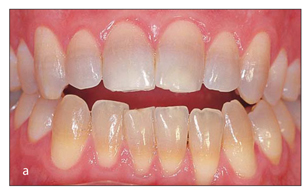
Initial clinical presentation of patient with tetracycline staining reveals a banded appearance. The darker gray band in the middle portion of the tooth will be most resistant to bleaching.
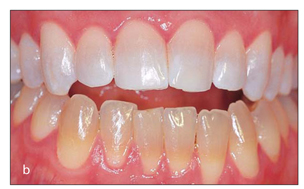
After 1 month of nightly tray bleaching with 10% carbamide peroxide, the incisal edges are responding well, but the band is still evident. The untreated mandibular teeth give an indication of the amount of color change achieved thus far.
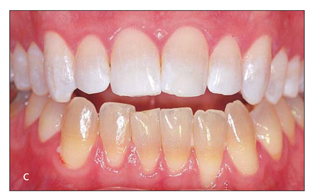
After 2 months of treatment, the color change is evident, but a subtle banding effect is still noticeable.
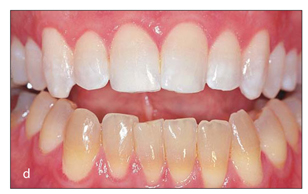
After 4 months of nighttime bleaching, the banding is only slightly visible. The patient, having both reasonable expectations for the gradual nature of the color change and the benefit of the untreated mandibular teeth as a point of reference, was motivated to continue treatment long enough to achieve a significant color improvement.
CASE 4 Maximum bleaching results
Teeth have an intrinsic maximum bleaching potential. Once they have reached this point, further treatment, regardless of the agent, concentration, or time, does not cause further lightening. In tetracycline-stained teeth, a minimum of 2 months of treatment should be attempted to determine if the teeth will respond. Once the teeth start responding, then the teeth should be evaluated monthly to determine their progress. When 1 month of treatment has passed with no obvious further color change, it is safe to assume the maximum bleaching result has been achieved.
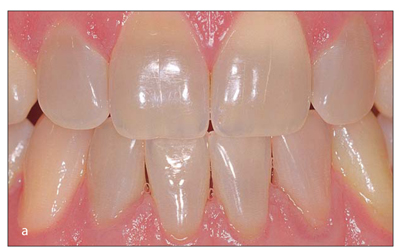
Tetracycline staining is the suspected cause of discoloration in this patient, who had previously considered veneers the only treatment option.
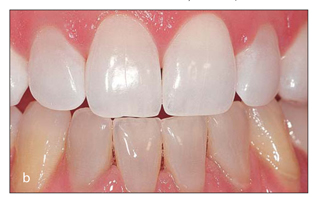
A dramatic outcome is achieved after 4 months of nightly bleaching using a nonscalloped tray with no reservoir and 10% carbamide peroxide. The patient experienced no problems with increased sensitivity.
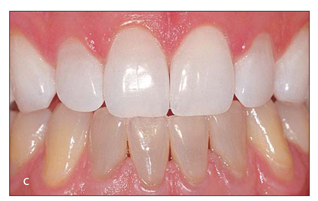
The patient wanted to continue treatment to reach maximum lightening of all teeth, so 6 additional months of bleaching were completed. The final result is very good; however, little additional whitening was achieved in the last 6 months of treatment, indicating that the teeth had essentially reached maximum lightness after 4 months of treatment.
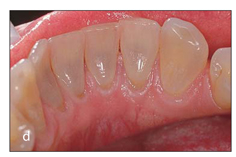
Lingual view of mandibular teeth demonstrates the extent of discoloration before bleaching.
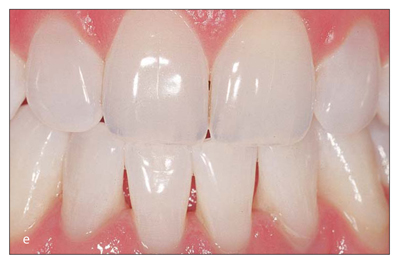
Following 5 months of bleaching in the mandibular arch, a good match to the maxillary teeth has been achieved. Mandibular teeth often take slightly longer to bleach than do maxillary teeth. Patients are often not as motivated to bleach the mandibular teeth since the teeth are not as visible as the maxillary teeth and are usually only seen when they are talking.
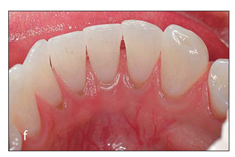
Bleaching was continued for an additional 5 months to satisfy the patient’s desire for maximum whitening. The lingual view shows the dramatic change in color.
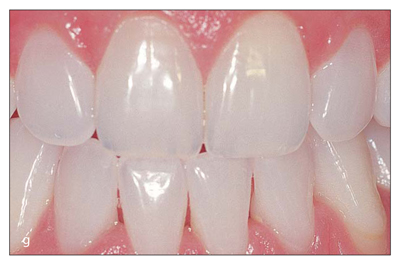
Results at 10 months are not significantly different than those achieved at 5 months, indicating the teeth had achieved their maximum lightening much earlier. However, the outcome for both arches is a dramatic improvement from baseline.
CASE 5 Incisal staining
Stay updated, free dental videos. Join our Telegram channel

VIDEdental - Online dental courses



